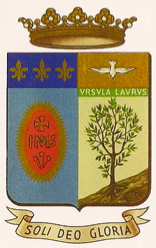The Roman Union
"The Roman Union, by its nature, is International."Constitutions of the Roman Union of the Order of St Ursula #7
Australian Ursulines are members of an international community known as Ursulines of the Roman Union.
The Soli Deo Gloria Crest
The Soli Deo Gloria crest was adopted by the 1947 General Chapter as the Coat of Arms for the Institute.
- On the left, the serene blue heaven, Angela's simplicity and openness. A fire of love surrounds the signs of the Passion and the interlaced initials of Jesus and Mary with a halo of glory.
- Above it, three lilies flourish in the deep blue of eternity: virginity, maternity and charity.
- On the right, against a shining silver summer sky, a laurel rooted deeply in the green mountain of God, symbol of glory and immortality, evokes for us Ursula (Laurus, anagram of Ursula).
- Above, in the gold of charity, a white dove, Spirit of the love of the Father and Son, covering with its shadow the branches which the laurel spreads throughout the world to make them bearers of life

How the Roman Union came into being
Founded in Brescia in Northern Italy in 1535 by St Angela Merici, the first Ursulines were a group of women who were drawn to following Jesus and a Gospel way of life, but they did not feel called to live in a monastery or take vows. St Angela founded a Company whose members remained within society often living in their own homes, gathering together for formation and prayer and serving their local community. In time the Company expanded to other cities in northern Italy.
Soon after the founding of the Company, the Council of Trent (1545-1563) authorised changes for religious women which were very different from Angela's original vision. However, the Company adapted in different ways. Some groups lived together while still maintaining their ministry within the local community. Others embarked on living a cloistered life which diminished their service of the wider community. To counteract this, schools attached to the monastery were established for the education of young girls. From this development Ursulines came to be known for their work in education.
Over a long period of time, Ursulines moved to other countries and continents. What had begun as a group of united independent women became communities subject to the local bishop and largely disconnected from each other, but recognised as a religious Order within the Church. Members of some French communities who were supported by their bishops were eager to unite together. Attempts to unite groups of Ursulines at the French bishops' General Assembly in 1635 failed to come to fruition.
Further significant attempts to form a Union of Ursulines were not realised until the second half of the 19th century. Church property in Rome was being confiscated by the Italian government, and the Ursuline monasteries were no exception. The Calvi dell'Umbria monastery which had been founded by Rome was experiencing great difficulties. Money was scarce, and the sisters were unable to exercise their ministry or welcome any new aspirants to their community. The monastery in Blois, France came to the aid of the Italian sisters by training new members and helping them financially. In order to do this canonically they had to form the union of Rome, Blois, Calvi. This union was approved by the Holy See, and Mother Marie St. Julien Aubry of Blois was elected Superior General.
This small union was a catalyst for a wider union. In 1898 Pope Leo XIII expressed a desire that Ursulines of the world be united under a general superior residing in Rome. Ursuline communities and the bishops of the diocese in which they resided were consulted regarding the issue and many communities agreed. However a significant number of Ursuline communities did not agree to be part of this new union at the time. Finally, in 1900 following several years of hardship, negotiation, disappointment, encouragement and vision, the Roman Union was formed. In the 20th Century many communities joined the Roman Union at various times and now the Union comprises 20 provinces. It was not until 1945 that the Australian Ursulines joined the Roman Union.

